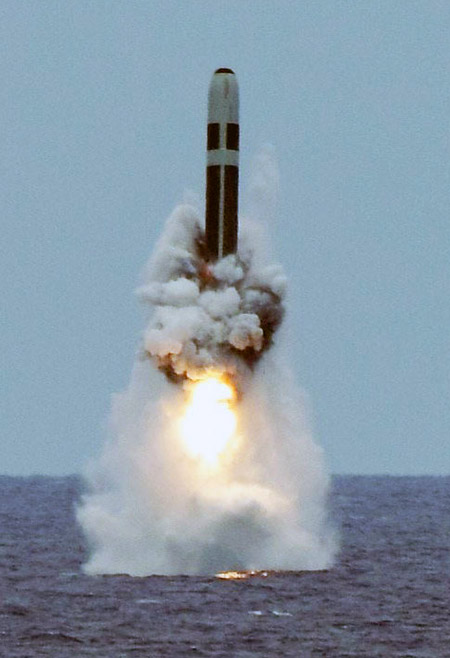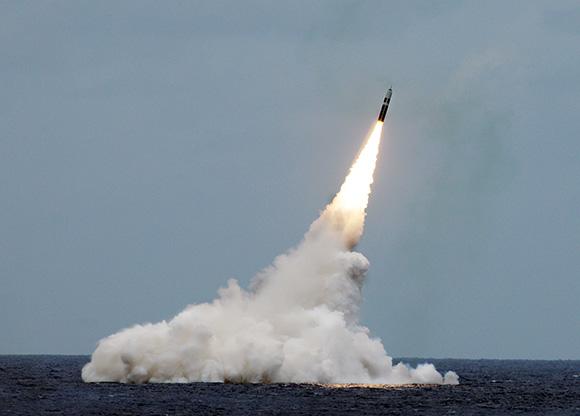The class ballistic submarine Ohio USS Maryland (SSBN-738 - photo at the bottom), launched an inertial-guided missile Trident II D5 unarmed in the Test Range East, off the coast of Florida, the 31 last August. This is stated in a joint note signed by Lockheed Martin and the US Navy.
It is the 161 ° test flight successfully performed for the usual three-stage propellant missile Trident II D5. The operation, called DASO-27, demonstrated the operational readiness of the strategic weapon system of an SSBN. The first update for i Trident will cover the MK6 LE guide system (software, algorithms, sensors, gyroscopes and accelerometers) which will replace the previous one dating back to the 80 years.
The US ballistic submarine fleet consists of 14 submarines armed with the Trident which currently carry around 1.000 tested. D5 production is currently set at twelve missiles a year at a cost of 30 million dollars each. Further updates, considering that i Trident they will remain in service until 2042, provide for the gradual replacement of the return section of the missile, the Mk-4, intended for housing the thermonuclear warhead. The new Mk-5 will be ready by the 2019.
I Trident they arm both the class submarines Ohio that Vanguard English. The USS Maryland is the 13 ° of the 18 class submarines Ohio of the United States Navy. Four of them, theOhio, Michigan, Florida and Georgia, were reconverted into 2003 to launch missiles Tomahawk. The USS Maryland is currently operating in the Atlantic Fleet based in Kings Bay, Georgia.
The Ohio Replacement Submarine program
- Ohio, the only American class to carry out patrols with nuclear weapons, they will begin to retire at the rate of one per year, starting with the 2029, when they reach the end of their operational life of 42 years. The directives drawn up in the program Ohio Replacement Submarine for the new SSBN-X they have an identical length to the class Ohio original, but with eight less missile tubes than the boomers currently in service.
 The new class of submarines will have to carry 16 launch tubes each, as opposed to the current 24's Ohio. Each pipe must have a diameter that will go from the current two meters and twenty-one centimeters to three meters and four centimeters, with the ability to launch nuclear and non-nuclear devices. The new boats will have to remain in service for 42 years.
The new class of submarines will have to carry 16 launch tubes each, as opposed to the current 24's Ohio. Each pipe must have a diameter that will go from the current two meters and twenty-one centimeters to three meters and four centimeters, with the ability to launch nuclear and non-nuclear devices. The new boats will have to remain in service for 42 years.
However, the US Navy aims to build the largest submarine of its arsenal, with a displacement of 20 thousand tons: almost half of the Typhoon Soviet, about 45 thousand tons and the same as the new one Borey Russian.
The SSBN-X will be armed with sixteen intercontinental missiles Trident II D5 LE (life extension). The missiles, equipped with a new steering system, will remain in service until the 2042.
The current operational service of 14 boomers costs the US Navy 110 million dollars. The new boats will have to obligatorily have a cost of 4,9 billions of dollars to hull (almost double of a Ohio with a final cost of 2,9 billion dollars).
Mission, to reduce costs far from easy. Suffice it to say that the leader of the 'X' will cost twelve billion dollars. The Navy has forecast an average expenditure of 5,36 billion by boat, which will go down, once production begins, to 4,9 billion hulled dollars. The total life cycle cost of all twelve new generation submarines is set at 347 billion dollars. Figures obviously denied by the Congressional Budget Office, which in October of the 2013 estimated its procurement costs in 87 billions of dollars and the billions of dollars for the total cost of development (including research and development) in 100.
- Ohio will start retiring at the rate of one a year from the 2029. This means that the first X will have to be put into production within the 2019, with sea tests scheduled in the 2026 and the first deterrent service between the 2029 and the 2031. However these estimates are absolutely optimistic, considering that the US Navy has already announced that the entire program is two years late.
The SSBN-X program could absorb one-third of the Navy's total budget for the 2020 / 2030, reducing the ability to purchase more ships and modernize the fleet. Among the solutions proposed to reduce costs and avoid slowing down other similar programs, the purchase of an SSBN-X every two years, so as to try to reduce the impact of the program on the funds available for other ships or the creation of a fund specific, as happened for missile defense.
In a report of the 2011, theManagement and Budget Office (OMB) suggested to the Navy to reduce the number of Xs (from twelve to ten), bringing to twenty the launch tubes on each submarine. This would have saved at least seven billion dollars. Another report from the 2013 by the Stimson Center suggested reducing the fleet of 'X' (from twelve to ten), but with the same launching capacity as sixteen submarine missiles. In this way, the Navy would have immediately saved a billion dollars and another ten in the next decade. In another report of the 2013 Congressional Budget Office, the possibility of reducing the fleet of new submarines to eight boats is analyzed. The savings would amount to 15,7 billion dollars for the 2015-2023 and another forty in the following decade.
According to the studies carried out, a force of eight submarines would represent a powerful deterrent force and the ability to have an optimal number of missiles at sea for the First and Second Strike. The twelve boats will guarantee the Navy's nuclear strategic deterrent service with ten X submarines always operational and available at any time and two in maintenance.
The new SSBN force will carry around 70 percent of US nuclear warheads.

(photo: US Navy)












